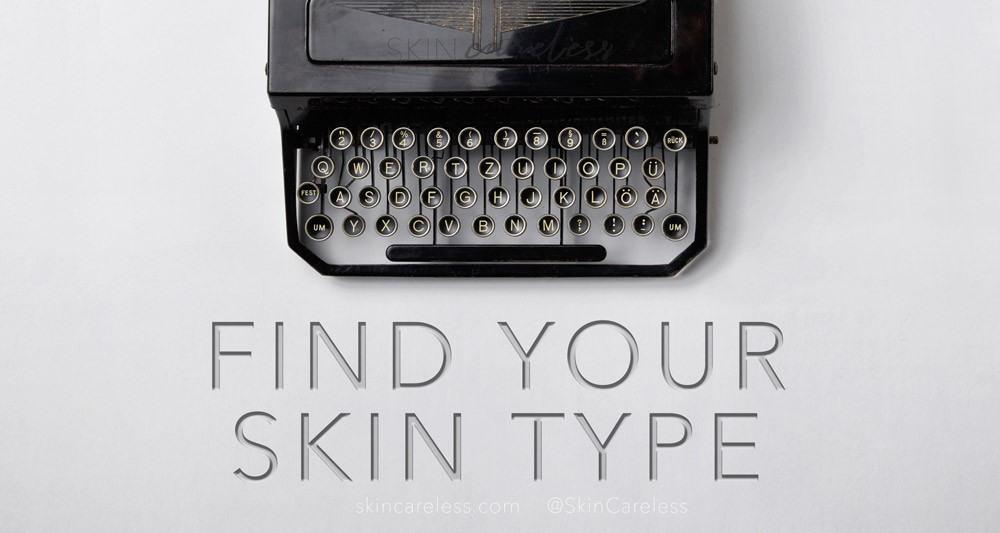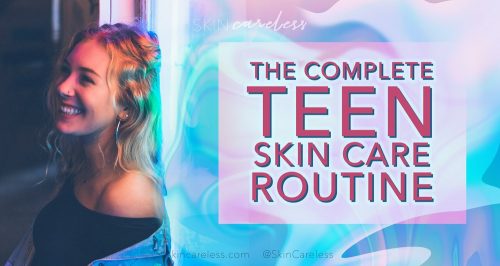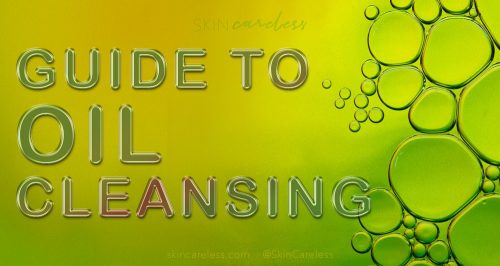The most common question I hear from beginners just dipping their toes into the world of skin care is “How can I figure my skin type?“.
Look at any Pinterest board, forum, or magazine column and you’ll see this question thousands of times over. Wanting to know your skin type usually comes from a place of confusion – and for good reason, because it can seem like a complicated topic.
You hear a lot of talk about skin types from companies trying to sell you their new cream or miracle treatment -“great for dry skin” or “oil reducing” – ring any bells?
When you’re hoping to create your first skin care routine, often you’ll get suggestions like ‘Moisturiser’ or ‘Cleanser’ – but how are you supposed to choose which one?
That’s where skin type comes in – it’s a great way to get you started looking at products which will best suit your general skin’s needs.
Disclaimer: There is lots more to your skin than just your skin type: like your skin conditions and issues, your environment, and your current habits and routine. Start here, but don’t forget to keep going and build a complete idea of your skin for the best results! I’ll link to where you can read about those things at the end.
With that out of the way, let’s talk about skin types, how to identify them, and how should you care for yours.
Introducing the skin types – Dry, Normal, Oily & Combination
Your skin type refers to how much oil you naturally produce throughout the day. The basic types are dry, normal, combination and oily.
Dry skin has next to no oil production, leaving skin vulnerable to dehydration. It’s more common as people move into middle age.
Normal skin is somewhat balanced and produces enough oil to feel supple but not greasy. Think of this as the ‘ideal’ skin type.
Oily skin is just that – oily. It’s quick to produce oil and tends to overdo it by the end of the day.
Combination skin has areas of a dry, normal or oily nature. Typical combination skin might be oilier in the T-Zone (on the forehead, down the nose and on the chin) and drier in the cheeks. You might have to care for these different areas with different products.
What is skin type influenced by?
Your true skin type can be influenced only really be influence by three things: genetic traits, age and medicinal effects.
Testosterone and androgen production in pubescent teens leads to oilier skin and hair, which as we age generally wears off. By the time women reach menopause, oestrogen loss can trigger dry skin.
You could also see changes if you start hardcore prescription medications including Accutane – which can drastically reduce oil production but comes at a cost – or female/male sex hormones which will likely increase oil production with the addition of testosterone, and reduce it while on testosterone blockers.
If you experience a huge lifestyle change or other stress, affected hormones could lead to a skin type change in any direction – drier or oilier.
Overall, your DNA really has the final say in how much oil you will produce (thanks mum and dad!)
This means that unless you are still going through puberty or medical treatment, you’re likely stuck with the skin type you currently have. Sorry! But there are lots of ways to handle your skin no matter what type it is.
How to identify your skin type, and what products to use for it
Dry skin
If your skin never appears greasy, but has a tendency to look dull, dry, flaky or tight, you might have a dry skin type.
Dry skin, lacking oil, needs a rich moisturiser with oils and butters to keep the skin flexible, supple and encourage hydration. Cleanse with a creamy, non-drying cleanser or micellar water to avoid dry skin’s downfall, dehydration. Dry skin will also need richer, heavier moisturisers to the same end.
Normal skin
If your skin feels neither greasy nor dry, and you don’t usually suffer from many skin issues, you have normal skin.
This type of skin is usually clearer, more resilient, and thus desirable. Whichever moisturiser feels comfortable on your skin, discourages dryness and doesn’t get greasy should be fine, you lucky thing! You can cleanse with either a cream or a foaming cleanser, whichever your skin prefers. Normal skin can use a lightweight or rich moisturiser depending on their preference. You can still suffer from a bad skin condition (think sensitivity, acne or anything else like that) with normal skin, it’s just less common than with the other skin types.
Oily skin
If your skin appears visibly greasy within a few hours after washing, you might have an oily skin type.
Those with very oily skin should aim for lighter cream or gel moisturisers that have a matte finish if you’d like to discourage the shiny appearance. Blotting sheets are super useful to soak up excess oil, even over makeup. You can probably get away with a more thorough foaming cleanser than your dry and normal peers, as your skin is often more resilient and hydrated than your dry counterparts. To prevent dehydration, I recommend a lighter weight moisturiser. Note that just because you’re using acne-fighting products, doesn’t mean you can’t still have a hydrating and soothing routine! People with oily skin tend to be more prone to skin conditions like acne as well as fungal folliculitis.
Let’s recap!
There are four main skin types – DRY, NORMAL, OILY, and COMBINATION. They refer to the amount of oil your skin produces (which can sometimes vary between areas in the case of combination skin) and dictate the products you should use, as well as the likelihood you will experience a skin condition at some point in your life. Those with normal skin are the least likely to suffer from further skin conditions (more on this tomorrow!). And yes, you’re pretty much stuck with the skin type you’re born with. But there are benefits to each person’s unique skin, so be grateful for what you’ve got! By treating your skin type correctly, you’ll be well on the right track to clear and healthy skin.
Still feel like you don’t know why your skin is acting the way it is? Remember, skin type isn’t all there is to good skin. You’ll also want to see whether you’re suffering from a skin condition or issue – an additional, temporary state of skin that’s in need of a bit of extra help. To get started treating common skin conditions, read more here about what they are and some of the most common ones you’ll find.






[…] like plant extracts, antioxidants and more. A good, basic moisturiser should be geared towards your skin type and condition, and contain some key moisturising […]
[…] so go for it! There are clay masks for the oily among us, or hydrating sheet masks if you’re more of a dry skin type. Masks go great on a Christmas or birthday wish list, because then you can build a collection try a […]
[…] you use products that don’t agree with your natural oil production or skin type, they won’t layer properly, adhere to each other and stay adhered to your skin […]